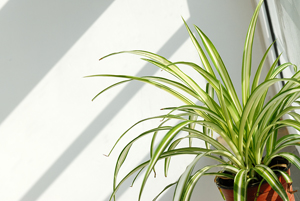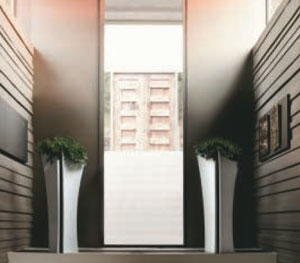Dotted around the kitchen or nestled in the corner of a deck, potted plants hold immeasurable appeal. They bring nature into our midst, raise our spirits and make us feel better — literally!
By Karen Booth
Indoor plants and health benefits
Indoor plants with lots of healthy foliage improve air quality by removing air-borne pollutants including volatile organic compounds (VOCs), which are emitted from synthetic materials (such as furniture) and plastic. Cleaner air means less drowsiness and clearer thinking.
Flexibility and warm welcome
Potted plants also hold appeal because of their portability and flexibility. If a plant isn’t thriving in one spot or you simply feel like a change, pick it up and move it to another. The decorative possibilities are endless, too. Both the plant and container can be used as a design feature, with the colour, texture and patterning of plant and pot becoming integral elements of the décor. Inside the home or in a closed-in outdoor room, potted plants make a space feel more welcoming and give the sense of being in touch with the natural world. Of course, there really isn’t such a thing as a true indoor plant; rather, there are plants whose natural habitats make them better adapted to life indoors. It is often said that plants will survive but not thrive indoors, but if you understand a little of the plant’s origins, it will help you to give it the best possible conditions and the best chance of a long and happy life.
Location, location
Many indoor plants come from tropical and sub-tropical rainforests where they have warmth, little direct sunlight because of an overhead tree canopy, high humidity and regular rainfall. Most of these will do best in a warm, light spot, but make sure to avoid draughts, direct sunlight, dark places and temperature fluctuations (which means not putting them up against windows or near heaters in winter).
If you’re new to house plants or you have poor indoor light, opt for the tougher foliage plants such as bromeliads, mother-in-law’s tongue (Sansevieria), cast iron plant (Aspidistra elatior), spider plant (Chlorophytum comosum), Philodendron sp., Anthurium sp., peace lily (Spathiphyllum sp.) , rubber tree (Ficus elastica), Zanzibar gem (Zamioculcas zamiifolia) and yucca (Yucca elephantipes). Flowering plants require more light and care but can be worth the extra effort.
Monitoring weather conditions
The humidity indoor plants need can be created in a number of ways. Mist the leaves daily (but not for fleshy-leafed plants such as African violet and cyclamen), stand pots on trays of damp peat or pebbles; or group plants together. Plants like plenty of fresh air so avoid unventilated rooms. Take them on regular excursions to a shady spot outdoors — either for a few weeks at a time or for most of summer. They particularly like being placed outside in a gentle rainstorm.
Water and fertilisation needs
Whether a potted plant lives or dies will have a lot to do with correct watering. The amount of water required depends on the size and type of plant, the size and type of pot, the type of potting mix, the location of the plant and the climatic conditions. Also keep in mind that more indoor plants are lost from over-watering — where the soil becomes waterlogged and the roots suffocate — than under-watering.
Resist the temptation to save money and use garden soil in pots. Use a porous free-draining potting mix as garden soil tends to be heavy, drains poorly and sets hard. When choosing a potting mix, look for the Australian StandardsMark “ticks” that indicate the mix has passed stringent quality tests.
When potting or re-potting, use water storing granules. Although they can be incorporated around the roots of already potted plants, this isn’t very successful and they are best combined with the soil mix when you are re-potting. Alternatively, you can simply buy a premium grade potting mix which already has the wetting agent mixed in.
All plants in pots will require regular fertilising to replace the nutrients they have used up. Slow-release fertilisers are the easiest way to feed plants in containers. Apply once or twice a year, according to the instructions on the packet. These can be incorporated into the potting mix when re-potting, but remember that a premium brand will have enough in it for some weeks. Another option is to sprinkle granules on top of the soil.
Most potted plants benefit from regular supplementary liquid feeding in the growing season. Give fortnightly applications in spring and summer. It is a good idea to vary the fertiliser used, depending on whether it’s a foliage or flowering plant and according to the flowering season.
Re-potting
Most house plants require regular re-potting. As they grow they use up all the nutrients in the soil and the pot becomes overcrowded with roots.
Before re-potting, check for pests and diseases. If you find any, get rid of them and let the plant settle down for a week or two before re-potting. And avoid over-potting — placing plants in a pot that is much larger than the existing pot. If the pot is too big, the soil becomes water-logged and turns sour through lack of aeration. Choose a pot only one or two sizes bigger than the existing pot.
Not all plants need be grown in pots standing on a floor or perched on a table or shelf. Attractive used indoors and out, hanging baskets are ideal for trailing and leafy plants, ferns, stunning flowering plants such as the goldfish plant (Columnea gloriosa) and for colourful annuals such as primulas and petunias. If using a mix of plants, place the cascading ones around the sides of the basket.
For indoors, use plastic containers with a drip tray attached. Outdoors you can remove the tray to allow free drainage. When a tray is used, ensure that any water which accumulates is emptied regularly. Also remember that hanging baskets dry out quickly, especially in hot or windy weather, so use a good quality potting mix with a wetting agent added and water regularly.









 Interior designers Hunter and Richards transformed this period home from the inside out
Interior designers Hunter and Richards transformed this period home from the inside out